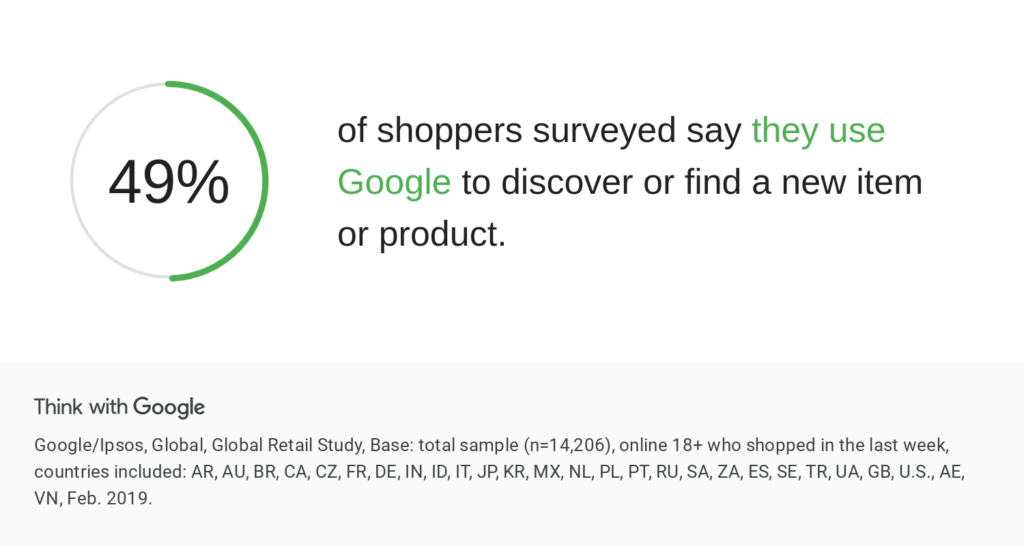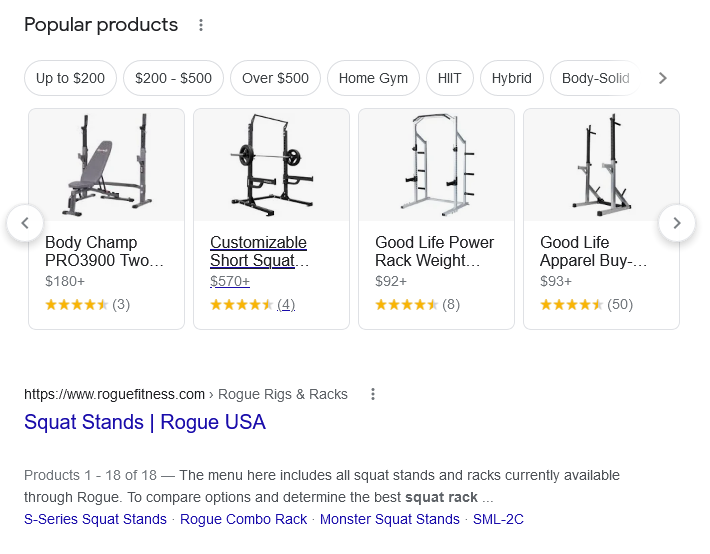To break into the highly competitive eCommerce space, it’s often not enough to use run-of-the-mill SEO tactics.
While it’s still just as important to do keyword research, optimize your website’s performance, and take other general SEO measures, there’s far more you need to do if you want to compete with the thousands of other online stores.
On top of essentials like on-page SEO, there are several eCommerce-specific SEO actions you can go for. Many of these are similar to what you are already doing, but specialized to get more eyes on your products.
In this article, we’re going to dig into those methods that boost your online store in the SERPs.
Why Bother With Ecommerce SEO?

It’s already enough work covering all the bases of SEO-optimizing your site. Now you have to deal with even more steps to get your products on par?
It may take some extra work, but investing your time in eCommerce SEO is well worth the effort. 44% of online shoppers start their journey with a search engine and 37.5% of eCommerce traffic comes from search alone. That means you need to optimize for the SERPs as much as you possibly can. Cut no corners with SEO!
In addition, 49% of shoppers say they use Google to discover or find products. About as many also say they use the search engine to research online purchases they plan on making. This is why it’s so important to upload a good image and optimize your product descriptions in order to attract clicks from sources like Google Shopping.
On the other hand, statistics also show that an even higher number of people (63%) start searching directly on Amazon. This is unfortunate for businesses who don’t cross-post their products on online marketplaces, but it’s all the more reason you need to capture clicks from those who do use search engines.
Finally, 70% of marketers believe that SEO drives more sales than pay-per-click advertising. These days, just about everyone is using an ad blocker — these block not just traditional banner ads, but also sponsored results in Google — so the effectiveness of PPC is vastly diminished.
Ad blocking may be common, but who isn’t using search engines? Nailing that top spot in the SERPs, or at least landing on the front page, can be your one-way ticket to success.
What’s “Normal” SEO?
Let’s take a minute to define standard SEO measures. These are just as important to follow to create a baseline for your online store, and many of these, such as keyword research, play into ecommerce SEO practices.
- Keyword research — Arguably the most important of SEO tactics, this involves researching the best-ranking and upcoming keywords and distributing them throughout your content.
- Optimizing static pages (About, FAQ, Contact, etc.) — You might be surprised how important it is to optimize those small static pages on your site with good keyword usage.
- URLs and permalink structure — URLs matter for SEO. Addresses that are human-readable, rather than random strings of numbers or text, are better for ranking. Using keywords is a good idea too, but you should keep it short.
- XML Sitemaps — Submitting and optimizing an XML sitemap can get your pages crawled faster and increase SEO.
- Robots.txt — A poorly optimized
robots.txtfile can seriously damage your search performance, while a properly written one can improve it by blocking off access to parts of your site you don’t want crawled. - Performance optimization — If there’s one thing that can majorly affect SEO, it’s performance. Slow loading speeds will do massive damage and kick you right off the front page.
- Mobile-first indexing — Google will heavily penalize you if your site isn’t responsive on all devices and doesn’t load quickly on slower mobile Internet.
- Google Search Console — Getting the hang of Google Search Console is integral, as it comes with important analytics and lets you submit a sitemap directly to the search engine. This data also allows you to take informed actions for improving your site.
- Off-site optimization — It’s not just what you do on your site that matters. Link building, branding, and social metrics also play a role in SEO, while retargeting techniques can guide more users to your website.
SEO Tactics to Increase Ecommerce Traffic
Now that you know the basics of “normal” SEO, what about eCommerce-specific tactics? Remembering to do keyword research, set proper URLs, and optimize performance will also help eCommerce stores, but there’s more you can do, and there are special tactics to optimize product pages in particular. Here’s how to do it right.
Optimize Your Category Pages
Time to start building up your store. Where better to begin than the category pages?
This is the baseline of your site’s navigation as well as a good source of customers if optimized well. If there’s one thing too many stores do, it’s undervaluing the category page.

The most common bad practice is simply choosing to ignore the page, which is easy to do, especially if you’re using WooCommerce. The page will automatically populate itself with products as you categorize them, so you may not ever even look at it.
This is a big mistake, since the default page can look fairly bare design-wise, and you’re missing out on an opportunity to include more keywords on the page.
Here’s where you should be optimizing keywords on your category page:
- The category names themselves should be a ranking keyword!
- In your page title and headers, especially your H1 header. To draw the most organic traffic, put the category and keywords rather than your brand name first in the page title.
- You should add a custom meta description to category pages, or else Google could end up pulling unrelated text off the page.
- Many designers hesitate to add copy to category pages; who wants to scroll past an essay when they’re trying to shop? But adding a small blurb at the bottom that strategically uses ranking keywords can be a great idea.
- If you add featured products or other internal advertisements, use text rather than banners and images to promote them to make sure you’re ranking for keywords.
Another common mistake is having a messy URL slug. Set your category URLs to be clean, such as example.com/category/designer-purses, or better yet, example.com/designer-purses.
Finally, you may need to use canonical URLs if your category pages have a search, pagination, or filter tool.
Set Up Your Product Pages for SEO Success
What makes an optimized product page? Every one must have these elements:
- A unique product description. Optionally product specs, an FAQ, and a shorter blurb for promotion on other pages.
- Product photos and videos.
- A CTA such as Buy Now or Add to cart.
- Info like price, availability, product variations, etc.
- Reviews from customers who bought the item.
With all of this, you have a solid product page that’s ready to be optimized with keyword research and other SEO tactics. For more details, check our article on eCommerce UI design and mobile design for online shops.
You want your product pages to be unique. Too many stores make the mistake of using the manufacturer descriptions, which can get you penalized for duplicate content and are rarely compelling anyway.
If you want to stand out front the competition, everything must be original content written with user interest and keyword research in mind. Optimize for search engines, but design for users.
That also goes for your metadata. Many stores use a generic meta description that’s identical across all product pages. Writing a unique description that targets users and keywords both is far more likely to attract attention.
Finally, it’s important that your product pages load quickly and are responsive on mobile devices. With mobile commerce making up such a large chunk of eCommerce traffic, and load time a major factor in bounce rate, this is imperative.
There’s much more you can do to optimize your product pages, including internal linking and image optimization, so let’s keep going.
Create an Effective Internal Linking Structure
One of the best ways to build up SEO and get eyes on your products is with a good internal linking structure. Follow these best practices:
- Keep link depth to products minimal. This is the number of clicks it takes to get from the homepage to the target page. For example, clicking the homepage, category page, and then reaching a product page is a good link depth. You could even link to some products on your homepage.
- Design clean and straightforward navigation. It should be easy to find products and categories in your shop both from your homepage and with the menus.
- Link to your most important categories on the homepage and menu. Leave niche sub-categories on the top-level category pages or in a category list to keep your main navigation short and sweet.
- Set up breadcrumb navigation for nested categories.
- Use dynamically generated popular, related, and recently viewed products to naturally link to your best items. Place these in categories, on the homepage, and especially on other product pages.
- If you also have tags, don’t use tags that are identical to any category.
- Make anchor, CTA, and button text relevant and use keywords, rather than just Click here.
- Use your blog to promote products and categories.
Optimize Your Product Images
Images may seem like a small part of eCommerce SEO, but there’s a lot to touch on here. Taking high-quality product images that will make people want to buy is only the first step. From there, you need to optimize these images for SEO.
How the picture looks doesn’t matter much for SEO, since crawlers can’t see them. What they can see, however, is metadata such as the file name and alt text, and how long it takes an image to load.
- Don’t just name your images a number or random string of letters. Take this chance to add keywords!
- Adding helpful ALT text for screen readers will give you an SEO boost on its own, but you can also naturally add a few keywords in.
- By adding multiple product showcase images on each page, you have the opportunity to use more keywords and get better SEO.
A common bad practice is uploading a huge image file to your site, which is bound to slow things down and get you penalized. Resize them and use an image compressor app to smush the file size down to under 100kb. Even large images should never be over 1mb.
On the other hand, grainy photos won’t make people want to purchase your goods. Compress just enough to strip unnecessary file size without damaging the quality of the image.
Implement Rich Snippets to Stand Out in Search
If you haven’t already set up schema markup on your site, you’re really missing out. In the primarily text-based Google search pages, a little bit of visual interest can go a long way.
Rich results personalize your pages when they appear in search, adding a photo, a star rating, a review snippet, and more. They’re only suitable for some types of pages, and it’s up to luck whether they display as a rich result, but even a small change can draw the eye and make you more likely to get clicks.
To get a rich result, you’ll need to set up structured data/schema markup on each page. You can add structured data manually, or WordPress users can simply use an SEO plugin like Yoast or All in One SEO which lets you do this without code. Dedicated schema markup plugins also exist and you can find them in the linked article.
As an eCommerce site, these rich snippets are most relevant to you:
- Product: Of course, the product snippet will be the one you use most. Show pricing, ratings, and more.
- Local Business: Have a physical store? Set up your local business knowledge panel.
- Logo: Show your business logo when people search for you.
- Review snippet: Display a snippet of reviews left on your products or business.
- Sitelinks searchbox: Let people search your catalog from Google.
- Breadcrumb: If you set up your categories and other pages correctly, breadcrumb rich results could help people navigate.
- Article: For eCommerce sites that come with a blog.
- Video: Show off your best product showcases.
The Importance of Ecommerce SEO
When it comes to online stores, “normal” SEO isn’t enough. While many of the common tactics do apply to eCommerce sites, there’s a lot more you need to do if you want to thrive in the competitive online market.
Ecommerce-specific SEO tactics such as designing category and product pages, optimizing internal product linking, taking advantage of multiple images, and creating rich snippets can all help you get the results you’re looking for.
Have you used these specific tactics with your online store’s SEO? Which worked out best for you? Let us know in the comments.



1 Comment